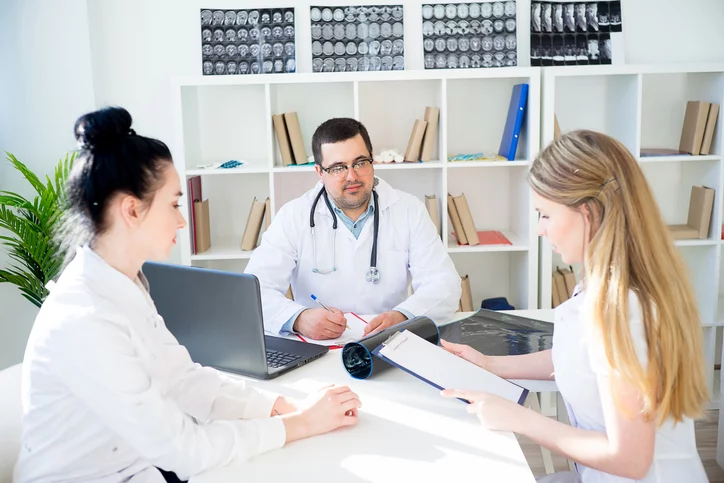The United States takes pride in its diversity. Serving as a melting pot of different cultures, it’s amazing to know that over 350 languages are being spoken in American households. While this diversity is definitely a cause for celebration, it also highlights a crucial issue in the nation’s healthcare settings.
Effective communication is paramount in healthcare settings since language barriers can and do compromise treatment. Taking the country’s cultural diversity into account, healthcare centers are receiving a growing number of patients who do not speak English or are limited English proficient (LEP), and legislative requirements have been passed to ensure health equity for all. For better context, over 25.7 million individuals in the U.S. speak a language other than English.
To ensure quality medical treatment for all, language service providers (LSPs), healthcare centers, and interpreters must actively collaborate to prepare for the growth of the country’s non-English speaking population.
Why Do Healthcare Providers Struggle to Provide Language Services

To ensure that every person has equal access to medical treatment, laws such as Title VI of the Civil Rights Act, Section 1557 of the Affordable Care Act, and the Americans with Disabilities Act require hospitals to provide language access services. These laws ensure that quality medical treatment is accessible to individuals who are limited English proficient or have disabilities (deaf or hard of hearing) that can prevent them from communicating effectively. Despite these regulations, hospitals continue to face significant challenges in delivering adequate language services.
1. Patient Diversity Varies Per Region
A diverse patient population can make it difficult for healthcare centers to provide equal support for all languages. Considering the large population of the United States, the demographic and linguistic needs of each region vary. Let’s compare big cities such as New York and Minneapolis as an example.
New York City’s Department of City Planning shared that New Yorkers speak over 200 different languages. After surveying different neighborhoods, they were able to pinpoint that Chinese, French, and Russian were some of the most prevalent languages in the city. On the other hand, research shows that the most common languages spoken in Minneapolis are Spanish, Somali, and Hmong. Through this example, it’s clear that there isn’t a one-size-fits-all solution for interpretation given that each city has its unique linguistic needs.
Moreover, influxes of immigrants and changing migration patterns can create new language communities within an area. The newer the language community is, the likelihood is that there will be a limited number of professional interpreters for that language. Moreover, learning a new language and attaining native proficiency takes a substantial amount of time and effort. Even if an individual within the community becomes bilingual, it’s not a guarantee that they’ll choose interpreting as a profession.
2. Overreliance on On-Site Interpreting and Bilingual Staff
There’s no denying the value of face-to-face interactions but relying on staff interpreters alone can lead to long waiting times and may result in a higher likelihood of canceled appointments for difficult-to-source languages. It’s difficult to maintain 24/7 coverage for all languages and even if a healthcare center has good coverage for in-demand languages in their area, they’re likely to have trouble maintaining that coverage during nights or weekends.
Contrary to best practices, some healthcare organizations address this gap by hiring bilingual staff. Technically, it’s okay to rely on bilingual staff if they have received training as interpreters and have met competency requirements. But if not, it’s important to be aware of the significant downsides of this practice.
First, hospitals need to provide ongoing interpreter training or pay high premiums if they have bilingual staff who are credentialed medical providers. Second, pulling a nurse or other care provider out of direct patient care to interpret may cost more than paying an interpreter. Doing so can create stress on co-workers who have to cover for staff members when they set aside their duties to interpret. The good news is most healthcare entities have moved away from leveraging bilingual staff and have understood that it is better to hire staff interpreters and work with local language service providers and remote interpreting services to provide full language access coverage.
On another note, some healthcare providers may be tempted to bridge the language gap by relying on the patient’s family and friends to interpret. This goes directly against recommended best practices and legal requirements. While some patients may have bilingual companions, it’s important to note that these individuals are not trained to understand and interpret complex processes and terminologies within the healthcare setting. This practice may lead to the inaccurate exchange of medical information which is highly risky and may lead to penalties or litigious situations.
3. Unpredictability of Emergency Situations
Emergencies add another layer of complexity to language services. Unlike consultations that can be scheduled and managed, hospitals can never predict when a Chinese or Spanish-speaking patient will get rushed to the emergency room. If there aren’t any staff interpreters available, failure to provide language support can increase the risk of medical errors.
What is Meant by On-Demand Interpretation?

On-demand interpretation simply refers to interpreting that is provided upon immediate request. With the help of video conferencing platforms, specialized applications, and smart devices, remote on-demand interpretation technology allows healthcare professionals to connect with qualified interpreters whenever and wherever they’re needed.
Traditionally, interpretation services have been provided on-site with an interpreter being physically present with healthcare professionals and patients. Because of the flexibility and ease of use that the service provides, remote on-demand interpretation can complement a hospital’s staff interpreters by providing swift and reliable language support during consultations, emergencies, and more.
How On-Demand Interpretation Technology Bridges the Language Gap: 5 Main Benefits

As stated in the previous section, many healthcare centers in the country tend to over-rely on on-site interpreters for language support. While valuable, on-site interpreting has its share of limitations, and depending on it alone can be inefficient. The good news is that healthcare centers can have a mix of onsite and on-demand interpretation to address their patient population’s linguistic needs. Here’s what on-demand interpretation technology brings to the table.
1. Cost Effective
Remote interpretation can’t fully replicate the value of an on-site encounter. But from an economic standpoint, on-demand interpretation can be a cost-effective solution. Let’s say your hospital requires more language support and you plan to source a contracted on-site interpreter to ease the load of your staff interpreters In addition to service fees, you should know that transportation and accommodation expenses will also drive up the total cost of services. In this instance, remote interpretation can be a lot more economical (especially for hospitals with a tight budget) since it removes these expenses completely.
2. On-Demand Access 24/7
Immediate on-demand access is arguably the biggest benefit of remote interpreting. Doctors, nurses, and hospital administrators can instantly acquire reliable medical interpretation through their chosen platform. Given that the unpredictability of emergencies is one of the biggest challenges of healthcare centers, remote interpreting can easily address this issue. In case a patient gets rushed to the emergency room and there aren’t any on-site interpreters available, on-demand interpretation can make all the difference in this life-or-death situation.
3. Global Accessibility
On-demand interpretation can be accessed from anywhere as long as the user has a stable phone or internet connection. This accessibility is especially valuable for hospitals in rural communities since the availability of on-site interpreters is significantly limited compared to cities. But whether your hospital is in a big city or a small rural community, remote interpreting ensures that full language support is provided.
4. Increases The Number of Medical Encounters That Can Be Accommodated
Hospitals deal with a large and unpredictable volume of patients daily. When on-site interpreters are overloaded, patients may have to wait long hours before they’re able to consult with their doctors. Fortunately, remote interpreting can support hospital staff by allowing them to cover more appointments that require an interpreter’s support.
Moreover, many large hospitals can either be very large single buildings or have multiple clinics and buildings spread across a large campus. On-site interpreters will need to walk from one site to another as they accommodate different appointments, and this can take up a huge chunk of their day. Remote interpreting allows hospitals to target their onsite interpreters to the departments where they are most needed. At the same time, remote interpreting is also useful for healthcare centers that have fluctuating interpretation demands or have a diverse patient population.
5. Access to Rare and Occasionally Needed Languages
Finding on-site interpreters for rare or occasionally needed languages can be difficult for hospitals due to the limited availability of interpreters. On-demand interpretation overcomes this limitation by letting healthcare providers connect with interpreters in hundreds of different languages. In our case, our partners can get in touch with a broad network of thousands of qualified and HIPAA-compliant interpreters across 300 languages through the Boostlingo Hub (BPIN).
How to Overcome Language Barriers in Healthcare: 6 Strategies and Solutions

Martin Luther King once said, “Of all the forms of inequality, injustice in health is the most shocking and the most inhuman.” In this light, one key to health equity is clear communication among healthcare providers and patients.
Helping LEP individuals to communicate effectively with doctors, nurses, and hospital staff is a proven way to reduce medical errors and improve patient outcomes. But to successfully bridge the language gap in healthcare, hospitals and LSPs must collaborate proactively. Here are some actionable steps your healthcare institution can take:
1. Implement an On-Demand Language Access Plan
Considering the benefits of on-demand interpretation technology, developing an on-demand language access plan should be your first course of action. Expanding your access to interpretation is a key step to ensuring health equity since it ensures immediate support 24/7 across a wide range of languages. In our case, our partners can get in touch with a broad network of qualified and HIPAA-compliant medical interpreters across 300 languages through the Boostlingo Hub (BPIN).
With that said, you must acquire technological solutions from a trusted partner. If you’re looking to implement an on-demand language service plan, there are several factors that your healthcare institution will need to consider. To help you find the best prospect possible, the Chief Revenue Officer of Boostlingo, Merrie Wallace, discusses how to find the right health equity partner for language services in this guest post.
2. Provide Cultural Awareness Training for Hospital Staff and Administrators
Providing cultural awareness training to hospital personnel is vital for creating an inclusive healthcare environment. By educating both staff and administrators, cultural awareness initiatives will allow them to understand the cultural dynamics of their hospital’s patient population. This newfound awareness can lead to improved collaboration with interpreters, fostering better communication and understanding of patient needs. Embracing a holistic approach also prepares medical professionals to navigate through cultural nuances that can significantly impact the quality of patient care.
3. Research Your Local Community’s Population
Understanding the linguistic demographics of your local community will allow you to determine the language needs of your healthcare center. One of the best ways to accomplish this is to make use of real-time indicators such as school enrollment by language statistics. Adopting a data-driven approach will help you pinpoint the predominant language communities that are within your service area and allow you to tailor your language services to the needs of your patient population.
4. Community Engagement and Interpreter Training Programs
Engage with language professionals, schools, and cultural centers within your area. Building good relations with them is a great way to start identifying and building a pool of qualified interpreters within your location. Being involved with your community not only enhances trust between your patients but will also allow your institution to be perceived as culturally competent.
5. Monitor Immigration Patterns and Refugee Crises
Stay informed about immigration patterns and refugee crises so you can anticipate the linguistic needs of incoming populations. For healthcare providers located where refugee populations arrive, it’s essential to connect with local refugee non-profits. These organizations can provide insights into the linguistic and cultural barriers that refugees face in accessing healthcare.
Fortunately, there are websites that track global migration annually, which can help your organization track the languages spoken by newly arrived refugee groups. Taking note of these websites will allow your healthcare center to proactively address the evolving linguistic landscape in your local community:
- Migration Policy Institute
- Migration Data Portal
- Interactive World Migration Report
- Office of Homeland Security Statistics
- United States Census Bureau
6. Translated Medical Documentation
Enhance communication within your healthcare organization by implementing translation for medical and patient forms. To be clear language access legislation requires the translation of a hospital’s most in-demand languages. As an example, Title VI of the Civil Rights Act includes translation as a key part of a compliant language access plan.
But whether you are legally bound or not, having translated medical documents will do wonders for your healthcare center. You can translate medical forms, instructions, and educational materials into widely spoken languages within your community. Doing so ensures that your patients can access and understand critical information. In addition to improving interactions, bilingual medical documentation can also enhance patient comprehension and compliance with medical recommendations.
The 10 Fastest Growing and Most In-Demand Languages for U.S. Healthcare in 2023
As you start implementing the strategies we’ve listed, remember to monitor the fastest-growing languages in the U.S. healthcare landscape. Doing so proactively will enable you to determine which languages may be most in demand for the coming year.
Last year, we took note of some of the fastest-growing languages in healthcare by analyzing the usage data of Boostlingo and decided to follow the same approach for 2023. Constant monitoring enabled us to identify which medical languages were most in demand in the healthcare network we serve.
As you read up on the list below, we just want to reiterate that these languages were determined based on hours of interpretation we’ve rendered to our clients. It’s important to consider that hospitals may have their unique linguistic needs which may be different from the list below:
1. Spanish
Spanish is the most in-demand medical language in the United States due to the country’s large Hispanic population. It’s estimated that there are over 57 million Spanish speakers in the nation, making it the second most spoken language in the country. As the nation’s largest ethnic minority, Spanish speakers are spread across different states, but a large majority reside in California, Texas, and Florida.
2. French
With a speaker population exceeding 2.2 million, French is currently the 6th most spoken language in the United States. Migration patterns and historical ties with France have resulted in robust Francophone communities in specific regions such as Louisiana, New York, and New England, where the language is actively used in households. Moreover, the demand for French language services has surged, propelled by immigrants and international visitors seeking medical care within the country.
3. Portuguese
Originating from Portugal and widely spoken in Brazil, Portuguese is gaining notable traction in the country’s healthcare landscape. Research shows that the population of Brazilian immigrants in the U.S. increased by almost 50% between 2010 to 2019 (roughly 340,000 to 502,000 people) and this figure continues to grow. Today, the U.S. has the largest population of Brazilian immigrants in the world. Healthcare centers located in states with a significant Brazilian population (e.g. New York, Massachusetts, Florida, and Canada) are experiencing a rising demand for Portuguese language services.
4. Arabic
Arabic has become a vital language in U.S. healthcare with over 1.4 million speakers. Delving into our nation’s history, the U.S. has experienced waves of Arab immigration beginning in the 19th century and migration continues to persist today. With a continuous influx of Arab immigrants and refugees, healthcare centers located in states with substantial Arab communities (e.g. California, Michigan, and Texas) need language support to serve the growing Arab community.
5. Vietnamese
In 2022, reports indicate that over 1.3 million Vietnamese immigrants live in the United States. Contributing to 3% of the total immigrant population, there are now over 1.4 million Vietnamese speakers in the United States making it the country’s 5th most spoken language. A large share of Vietnamese immigrants can be found in California and Texas. Healthcare centers in these states are experiencing a surge in demand for Vietnamese language services.
6. Swahili
As one of Africa’s most widely spoken languages, Swahili is gaining increased significance within the U.S. healthcare system. Originating in East Africa, Swahili speakers are dispersed across 14 countries, including Kenya, Guyana, and Somalia among others. Notably, research has revealed that the African immigrant population of the U.S. grew as much as 246% (600,000 to 2 million) between 2000 and 2019. This surge has led to an increase in Swahili speakers so healthcare centers must keep an eye out for this growing demographic.
7. Russian
The United States has a respectable Russian-speaking population that is estimated to have over 900,000 speakers mostly located in New York, California, New Jersey, and Illinois. Healthcare providers in these areas should monitor the growth of Russian speakers and develop a comprehensive language services plan to accommodate members of this community.
8. Regional Varieties of Spanish
As part of the greater Spanish-speaking immigration, Central American and Caribbean Spanish have experienced a great surge. Between 2010 to 2021, research shows that Venezuelans, Dominicans, and Guatemalans were among the 3 fastest growing Hispanic origin groups in the U.S. But while Spanish may be a dominant language for these communities, it’s important to note that language needs among ethnic groups may vary.
Let’s take Guatemala as an example. A great number of immigrants from this country come from non-Hispanic indigenous communities and may speak languages such as K’iche’, Mam, Q’anjob’al, Ixil, Akateko, and Kaqchike. In this case, Spanish may only be a secondary language so healthcare providers who serve this community must implement a language access plan that can cover these rare but in-demand languages. With that said, healthcare providers in California, Texas, Florida, and other states that have immigrants arriving from these regions will need processes in place to accurately identify the languages their patients speak and implement a strong language access and cultural awareness plan.
9. Pashto
Mainly spoken in Afghanistan and Pakistan, Pashto is becoming increasingly relevant in U.S. healthcare due to an influx of Pashto-speaking immigrants and refugees. The United Nations reports that over 28.3 million Afghans need humanitarian protection and assistance and that a large majority have sought asylum in the U.S. On the other hand, the latest figures indicate that the country’s Pakistani population has exceeded 550,000 individuals. Both factors emphasize the increased importance of Pashto language services in the country’s healthcare system.
10. Romanian
Romanian has emerged as one of the fastest-growing languages in US healthcare. Unlike the other mentioned languages where speakers are spread across different states, Romanian speakers in the U.S. are concentrated in only a few areas. Research shows that New York has the largest share of Romanian individuals (55,037) while the next two states would be Illinois (34,958) and Michigan (27,433).
Bridge The Language Gap for Your Doctors and Patients
The linguistic diversity of the United States presents both opportunities and challenges for the healthcare sector. While on-site interpretation remains an essential component of language access, it has real limitations. Fortunately, the language industry is ever-evolving, and the emergence of on-demand interpretation has paved the way for an improved healthcare system.
Implementing the actionable strategies above and taking note of the most in-demand languages for healthcare is the first step to equitable medical care. If you’re searching for a partner that will provide quality interpreter services for healthcare, Boostlingo offers quick and reliable access to qualified healthcare interpreters of widely spoken languages in the United States. With an average response time of 13 seconds, rest assured that you’ll be able to connect with a qualified interpreter in no time.
Interested? Feel free to look at our supported languages list or contact us today!



